#Centrocercus urophasianus
Photo
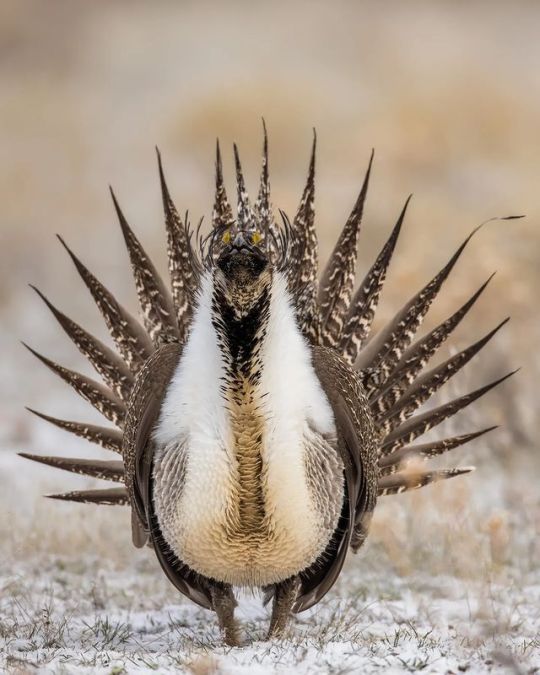
Greater Sage-grouse
54 notes
·
View notes
Text
BOTD: Greater Sage-Grouse
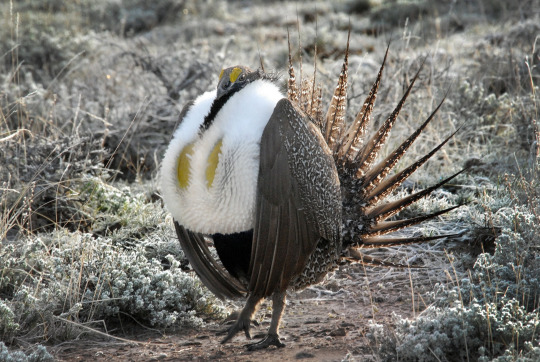
Photo: Dan Dzurisin
"Well-named, this very large grouse is found nowhere except in sagebrush country of the west. It nests on the ground among the sage, and the leaves of this plant are its staple diet in winter. The Sage Grouse is best known for the spectacular courtship displays of the males: Large numbers (up to 70 or more) will gather in spring on traditional dancing grounds and strut with their chests puffed out and spiky tails spread, hoping to attract females."
- Audubon Field Guide
#birds#birds of north america#greater sage grouse#grouse#birds of america#north american birds#american birds#birds of the us#bird#bird watching#birding#birdblr#birblr#landfowl#Centrocercus urophasianus
29 notes
·
View notes
Text
In a few cases (e.g., Hanuman Langurs, Lions, Sage Grouse) scientists have even suggested that females turn to one another because they have not been "satisfied" or received enough attention from male partners – a version of the widespread stereotype about the "cause" of lesbianism among people.
"Biological Exuberance: Animal Homosexuality and Natural Diversity" - Bruce Bagemihl
#book quote#biological exuberance#bruce bagemihl#nonfiction#hanuman langur#presbytis entellus#lion#panthera leo#sage grouse#centrocercus urophasianus#lesbian#unsatisfied
0 notes
Text
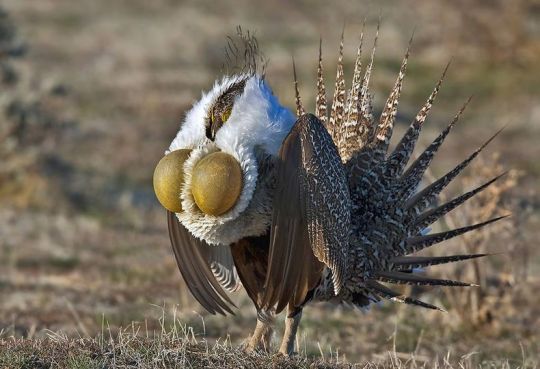
Greater Sage-Grouse (Centrocercus urophasianus), male courtship display, family Phasianidae, order Galliformes, Wyoming, USA
photograph by Alan D. Wilson
#sage grous#grouse#centrocercus#phasianidae#galliformes#bird#ornithology#animals#nature#north america
1K notes
·
View notes
Text
Birdwomen
Family: Harpyidae
Birdwomen are the most common of magical creatures, appearing on every continent except for Antarctica*. Opportunistic omnivores, birdwomen take the form of massive carrion birds, typically corvids, vultures, condors and eagles, with the heads of women. They appear to be exclusively female; however, some species such as the Mediterranean harpy (Harpia strophades) do pair up during the mating season, with members impressing prospective partners by inflating a pair of gular sacks at the base of the throat similar to the behaviour of frigatebirds (family Fregatidae) and the greater sage-grouse (Centrocercus urophasianus).
The magic of most species of birdwomen are affiliated with storms and disease. The alkonost (Harpia bilibinae) lays its eggs in the sea, and their hatching causes thunderstorms to form, while the droppings of the Mediterranean harpy immediately befoul food.
While most species are reluctant to directly attack humans, birdwomen have no qualms in consuming carrion. Multiple cultures report birdwomen as constant companions to sites of battle and bloodshed. Nordic myths of Valkyries spiriting away the dead are almost certainly inspired by the sight of Scandinavian species of birdwomen feasting on the bodies of the slain after battle, possibly the crested harpy (Valkyria cristatus), nicknamed by professional harpiers as the "Thor's falcon."
The North American birdwoman (Harpia canadensis) is the largest known species of birdwoman, with species standing between five and six feet tall, with respective wingspans of 12 to 15 feet wide. Easily identified by their black, iridescent plumage, North American birdwomen exhibit an intelligent, often playful and curious personality. While native to western and central Canada and the northwestern United States, one birdwoman was sighted in Point Pleasant, West Virginia through the late 1960s; following the 1967 Silver Bridge collapse, one harpier reported seeing this same birdwoman consuming the bodies of two disappeared travellers who had washed up downriver.
*Sightings of the "penguinwomen" of Antarctica are unsubstantiated and should not be counted as fact.
#harpies#unreality#narrativia#i have spiderwick on the brain and this happened#valkyries#norse mythology#mothman#cryptids
84 notes
·
View notes
Photo

Sage grouse (Centrocercus urophasianus)
Colorado, US
Photograph: Peter Ismert
#colorado#usa#birds#wildlife#nature#animals#snow#Photography#Lensblr#Aesthetic#Camera#Curators on tumblr#Peace#Travel#cute#fauna#cute animals#wildlifephotography#peace photography
508 notes
·
View notes
Text
BRACKET A
Greater Sage-Grouse (Centrocercus urophasianus)
Their gular sacks look like boobs and they bounce them around as part of their courting ritual. And they make this weird popping noise. Their crops aren’t large enough to digest seeds.
VERSUS
American Woodcock (Scolopax minor)
Their brains are upside down and they do a little dance to summon worms. Their nicknames include timberdoodle and bogsucker.
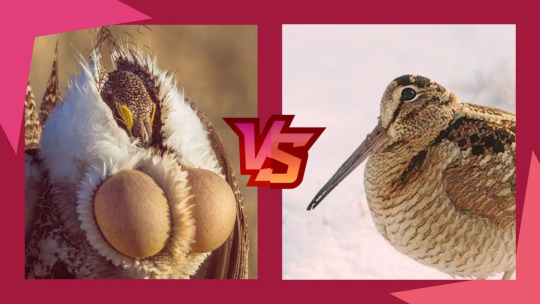
50 notes
·
View notes
Note
the birder is back at it again, completing the list :
Mid: Lyncornis macrotis (great eared nightjar) / alt: Sagittarius serpentarius (secretary bird)
Minute: Penelopides panini (visayan hornbill)
Pangi: Lybius bidentatus (double-toothed barbet) / alt: Dinopium benghalense (lesser golden-back woodpecker)
Rek: Leptotrygon veraguensis (olive-backed quail-dove) / alt: Gallicolumba keayi (negros bleeding-heart pigeon)
Terrain: Nothoprocta cinerascens (brushland tinamou)
plus, some additional alternative birds i skipped originally!
Ash: Centrocercus urophasianus (sagehen / greater sage-grouse)
Parrot: Cyclopsitta gulielmitertii (blue-fronted fig parrot) / alt-alt: Orthopsittaca manilatus (red-bellied macaw)
Branzy: Epimachus fastosus (black sicklebill)
Spep: Piranga rubra (summer tanager) / alt-alt: Cardinalis phoeniceus (vermilion cardinal)
.
11 notes
·
View notes
Text
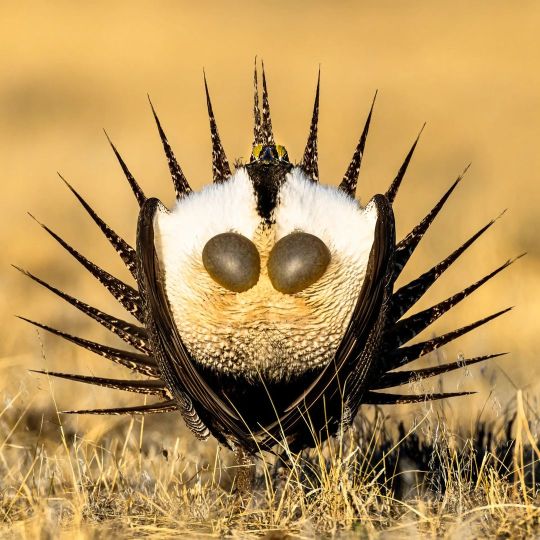
Sage grouse, Centrocercus urophasianus. Colorado, US
Photograph: Ly Dang
15 notes
·
View notes
Text
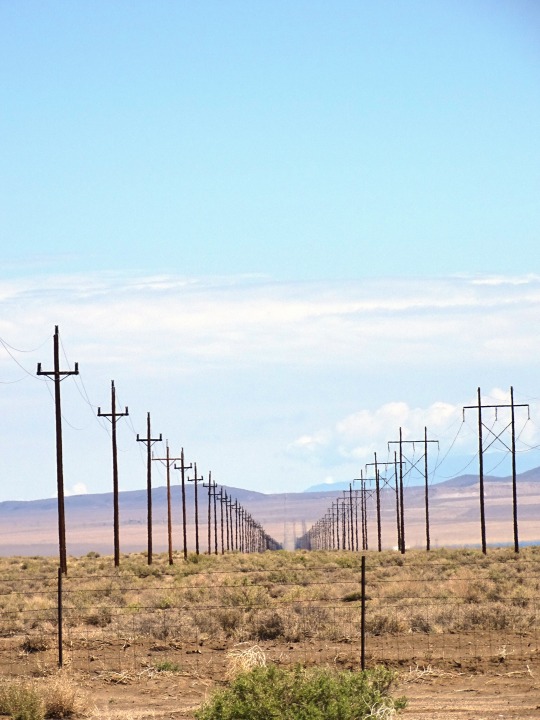

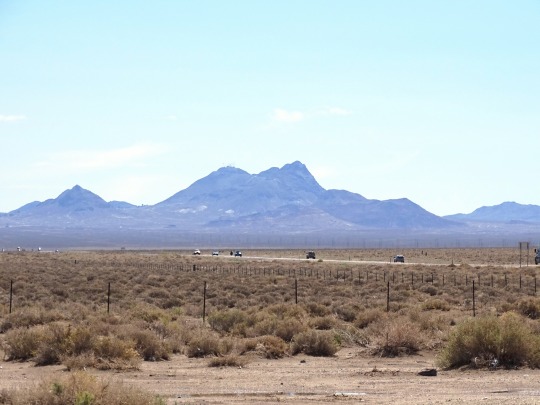
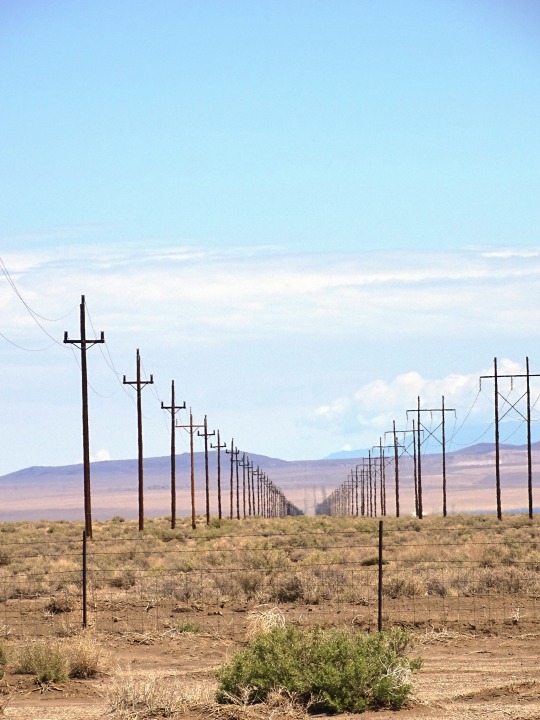
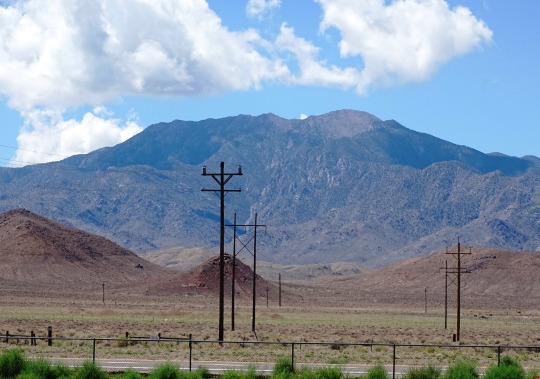


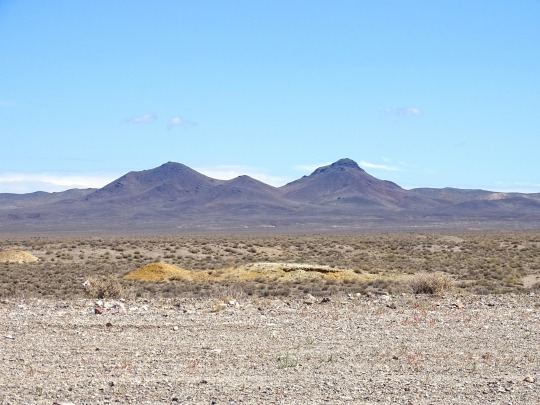


West-Central Nevada Desert, No. 1
The Great Basin Desert is part of the Great Basin between the Sierra Nevada and the Wasatch Range. The desert is a geographical region that largely overlaps the Great Basin shrub steppe defined by the World Wildlife Fund, and the Central Basin and Range ecoregion defined by the U.S. Environmental Protection Agency and United States Geological Survey. It is a temperate desert with hot, dry summers and snowy winters. The desert spans large portions of Nevada and Utah, and extends into eastern California. The desert is one of the four biologically defined deserts in North America, in addition to the Mojave, Sonoran, and Chihuahuan Deserts.
Basin and range topography characterizes the desert: wide valleys bordered by parallel mountain ranges generally oriented north–south. There are more than 33 peaks within the desert with summits higher than 9,800 feet (3,000 m), but valleys in the region are also high, most with elevations above 3,900 feet (1,200 m). The biological communities of the Great Basin Desert vary according to altitude: from low salty dry lakes, up through rolling sagebrush valleys, to pinyon-juniper forests. The significant variation between valleys and peaks has created a variety of habitat niches which has in turn led to many small, isolated populations of genetically unique plant and animal species throughout the region. According to Grayson, more than 600 species of vertebrates live in the floristic Great Basin, which has a similar areal footprint to the ecoregion. Sixty-three of these species have been identified as species of conservation concern due to contracting natural habitats (for example, Centrocercus urophasianus, Vulpes macrotis, Dipodomys ordii, and Phrynosoma platyrhinos).
The ecology of the desert varies across geography also. The desert's high elevation and location between mountain ranges influences regional climate: the desert formed by the rain shadow of the Sierra Nevada that blocks moisture from the Pacific Ocean, while the Rocky Mountains create a barrier effect that restricts moisture from the Gulf of Mexico. Different locations in the desert have different amounts of precipitation depending on the strength of these rain shadows. The environment is influenced by Pleistocene lakes that dried after the last ice age: Lake Lahontan and Lake Bonneville. Each of these lakes left different amounts of salinity and alkalinity.
Source: Wikipedia
#Millers Rest Area#West-Central Nevada Desert#Nye County#travel#original photography#vacation#tourist attraction#landmark#cityscape#USA#summer 2022#street scene#clouds#sign#mountains#Highway 95#landscape#desert#countryside#Hwy 95#Nevada#Great Basin Desert#telephone poles#flora
0 notes
Video
youtube
A INCRIVEL DANZA do Urogallo do as artemisas (Centrocercus urophasianus)
Neste vídeo, vamos dar uma olhada no INACREDITÁVEL Urogallo do as artemisas (Centrocercus urophasianus) . Esta ave é encontrada na área de TV Birding Tropics do America do Norte e habita o sudoeste dos Estados Unidos e Canadá . ☀️🌟☀️🌟☀️🌟☀️🌟☀️🌟☀️🌟 Também damos uma olhada em algumas das outras aves encontradas nesta área do Sudoeste da America do Norte, incluindo a Turdus migratorius (American Robin) , o Agelaius phoenicius (Red-winged blackbird) e o Dumetella carolinensis (Gray Catbird) . ☀️🌟☀️🌟☀️🌟☀️🌟☀️🌟☀️🌟 Este vídeo é uma ótima oportunidade para aprender alguns fatos interessantes sobre pássaros sobre o Urogallo de las Artemisas e alguns dos outros pássaros encontrados na área de TV Birding Tropics do Sudoeste do America do Norte ...Feliz Birding queridos amigos! ☀️🌟☀️🌟☀️🌟☀️🌟☀️🌟☀️🌟 O MAGNÍFICO Urogallo de las artemisias (Centrocercus urophasianus) …fotografia incrível Instagram📸 @wilsonaxpe @jason_tiesman_birdphoto @reidearl_photography @john.raptosh …vídeos incríveis 📹 @americanprairie …tirados na América do Norte Fotos em miniatura @wilsonaxpe @jason_tiesman_birdphotography @gary_kramer_photography ☀️🌟☀️🌟☀️🌟☀️🌟☀️🌟☀️🌟 📹📸Todos os créditos pertencem ao legítimo proprietário... o único propósito é educar e compartilhar este trabalho incrível com os outros... Siga-os para que você possa aprender mais sobre seu incrível trabalho!...Feliz Birding queridos amigos! ☀️🌟☀️🌟☀️🌟☀️🌟☀️🌟☀️🌟 📸📹🌟Marque @birdingtropicstv ou #birdingtropicstvbirdfacts para ser apresentado em nosso canal! ..Feliz Birding queridos amigos!🌟 ☀️🌟☀️🌟☀️🌟☀️🌟☀️🌟☀️🌟 @birdingtropicstv #birdingtropics #birdingtropicstv #birdingtropicsbirdingfacts #birdingtropicsbirdfacts #birdingmariqui #birdwatchingmariqui #felizbirding #happybirding ☀️🌟☀️🌟☀️🌟☀️🌟☀️🌟☀️🌟 #greatersagegrouse #Centrocercusurophasianus #birdsofnorthamerica #birdsofunitedstates #birdsofcanada #wilsonaxpe #jason_tiesman_photography #john_raptosh #americanprairie
0 notes
Photo
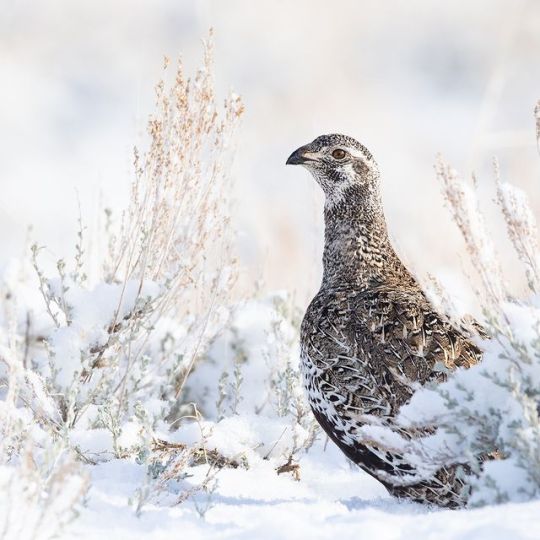
Greater Sage-grouse
#greater sage grouse#sage grouse#grouse#Centrocercus urophasianus#Galliformes#Phasianidae#Centrocercus#bird#upl
68 notes
·
View notes
Text
Chenopodium amaranth Reveals Antihyperglycemic Action in Temozolomide-Induced Diabetic person Test subjects
(h) '08 Elsevier N.Versus. Just about all legal rights set aside.Sagebrush (Artemisia spp.) ecosystems constitute the greatest individual Us plant ecosystem and supply crucial environmental, hydrological, biological, garden, along with recreational habitat services. Disruptions possess altered along with diminished this kind of ecosystem in the past, nevertheless java prices will in the end symbolize the maximum long term threat. Improved upon approaches to measure, check, and predict climate-driven continuous alternation in this specific habitat is important towards the future supervision. All of us looked at the particular once-a-year #Link# modify of Daymet rainfall (day-to-day gridded weather files) and five remote control sensing ecosystem sagebrush plant life along with dirt parts (simple terrain, herbaceous, kitten, sagebrush, as well as shrub) from 1984 for you to This year inside south western Wyoming. Blank #Link# floor viewable an escalating trend commonplace with time, along with herbaceous, kitten, shrub, along with sagebrush showed a decreasing trend. Overall rainfall quantities present a downhill development in the same time period. We all set up in past statistics considerable connections in between each sagebrush aspect along with historic rain data by using a easy least piazzas linear regression. While using historical relationship in between sagebrush element abundance along with precipitation in a linear model, we all predicted the abundance with the sagebrush parts throughout The year 2050 making use of Intergovernmental Panel on Climatic change (IPCC) rain cases A1B along with A2. Simple floor was the one ingredient that increased beneath #Link# the two future circumstances, having a world wide web enhance associated with 48.98 kilometers(A couple of) (One.1%) through the review region under the A1B circumstance and Forty-one.16 kilometer(Two) (2.9%) underneath the A2 scenario. The remaining factors decreased under both long term cases: litter box experienced the highest web discounts together with Forty-nine.Eighty two kilometres(Only two) (Four.1%) underneath A1B and also Fifty.8-10 kilometres(Two) (Four.2%) under A2, and herbaceous experienced the littlest web reductions along with 22.Ninety five km(2) (Three or more.8%) beneath A1B as well as Forty five.59 kilometer(2) (Several.3%) under A2. All of us applied your The year 2050 prediction sagebrush portion valuations to modern day (circa '06) greater sage-grouse (Centrocercus urophasianus) environment types to gauge the consequences involving possible climate-induced an environment modify. Within the The year 2050 IPCC A1B predicament, 11.6% regarding at the moment discovered nesting home was missing, and 2.002% of the latest probable habitat ended up being acquired, together with 4% involving summer habitat misplaced as well as Zero.039% obtained. Our benefits display your effective capacity associated with rural sensing centered sagebrush factors, any time as well as rain, to be able to prediction potential portion response utilizing IPCC precipitation cases. Our own approach also permits potential quantification associated with higher sage-grouse environment beneath various precipitation circumstances, and gives further chance to discover localised precipitation influence on sagebrush aspect response.
0 notes
Text
In a number of species such as Bonobos, Killer Whales, West Indian Manatees, Giraffes, Pronghorns, Common Murres, and Sage Grouse, homosexual interactions between two animals often develop into group sessions as more and more animals are drawn to the activity and join in.
"Biological Exuberance: Animal Homosexuality and Natural Diversity" - Bruce Bagemihl
#book quote#biological exuberance#bruce bagemihl#nonfiction#bonobo#pan paniscus#killer whale#orca#orcinus orca#west indian manatee#trichechus manatus#giraffe#giraffa camelopardalis#pronghorn#antilocapra americana#common murre#guillemot#uria aalge#sage grouse#centrocercus urophasianus#homosexuality#gay#lesbian
0 notes
Text

Greater Sage-Grouse (Centrocercus urophasianus), male displaying, family Phasianidae, order Galliformes, western U.S.
photograph by @jc_wings
#sage grouse#grouse#phasianidae#centrocercus#galliformes#bird#ornithology#animals#nature#north america
343 notes
·
View notes
Photo

Sage Grouse (Centrocercus urophasianus) male in courtship display at lek, North Dakota
Photographer: Steve Gettle
#steve gettle#photographer#sage grouse#grouse#bird#centrocercus urophasianus#north dakota#iek#nature
4 notes
·
View notes